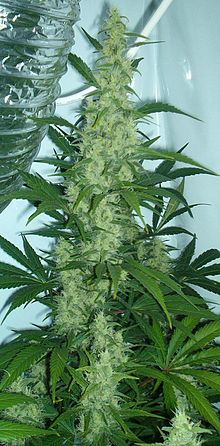Psychedelic plants
From Wikipedia, the free encyclopedia
| This article is in need of attention from an expert on the subject. Please help recruit one or improve this article yourself. See the talk page for details. Please consider using {{Expert-subject}} to associate this request with a WikiProject. (February 2009) |

Psychedelic plants are plants that contain psychedelic drugs. Some of them have been used for thousands of years for religious purposes.
Contents |
[edit] Cannabis
Cannabis (Marijuana) is a popular psychedelic plant. Cannabis is also unique in that it contains a psychedelic substance, THC, which contains no nitrogen and is not an indole, phenethylamine, anticholinergic (deliriant), or a disassociative drug. It is among the weakest of the psychedelics.[citation needed] Currently, certain universities and research firms are studying the medicinal effects of cannabis. Many US states such as California and many countries have created a Medical Cannabis law to allow patients to use cannabis as (among other things) a pain killer and appetite stimulant.
[edit] Plants containing psychedelic tryptamines

Many of the psychedelic plants contain dimethyltryptamine (DMT), which is either snorted (Virola, Yopo snuffs), smoked, or drunk with MAOIs (Ayahuasca). It can not simply be eaten, and it needs to be extremely concentrated to be smokable.
- Fittonia albivenis, a common ornamental plant from South America. The plant has unknown compounds, that reportedly cause "visions of eyeballs." It is also useful in the treatment of headaches, etc.
- Justicia pectoralis, DMT in leaves[1]
- Acer saccharinum (Silver Maple Tree) was found to contain the indole alkaloid gramine (not active and extremely toxic) 0.05% in the leaves, so it is possible that other members of this plant family contain active compounds.[2]
|
|
DMT, 5-MEO-DMT[3] |
 |
DMT, 5-MEO-DMT[3] |
|
|
DMT[3] |
|
|
DMT[3] |
|
|
5-MEO-DMT[3] |
|
|
DMT, 5-MEO-DMT[3] |
|
Shibam |
DMT[3] |
|
|
DMT[3] |
|
aff. litorale |
|
 |
DMT, 5-MEO-DMT[3] |
 |
5-MEO-DMT[3] |
|
|
DMT, 5-MEO-DMT[3] |
|
|
Traces of DMT[3] |
|
|
DMT[3] |
Apocynaceae family:
Fabaceae family (Leguminosae):
Caesalpinioideae (subfamily of Fabaceae) :
- Petalostylis cassioides: 0.4-0.5% tryptamine, DMT, etc. in leaves and stems[5]
- Petalostylis labicheoides, Tryptamines in leaves and stems, MAO's up to 0.5%[6]
|
|
Up to 1.5% alkaloids, mainly consisting of tryptamine in leaf[7] |
 |
Active principles in leaf[8] |
 |
β-methyl-phenethylamine[9], NMT and DMT in leaf (1.1-10.2 ppm)[10] |
 |
Tryptamine alkaloids.[11] Significant amount of tryptamine in the seeds.[12] |
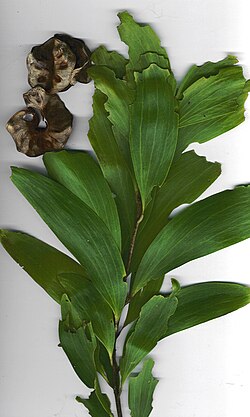 |
5-MeO-DMT in stem bark[13] |
 |
0.02% tryptamine and β-carbolines, in the leaf, Tetrahydroharman[8][14][15] |
|
|
Psychoactive[16] Ash used in Pituri.[17] |
 |
DMT, amphetamines, mescaline, nicotine[18] |
 |
DMT[3] and other tryptamines in leaf, bark |
 |
Psychoactive[19] |
|
|
DMT and other tryptamines in leaf, bark |
|
|
DMT[20] |
|
|
0.3% alkaloids in leaf and stem, almost all N-methyl-tetrahydroharman, with traces of tetrahydroharman, some of tryptamine[21][22][23] |
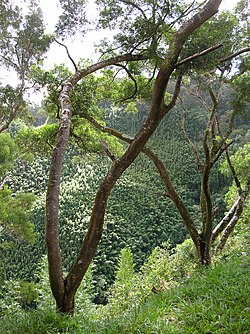 |
DMT & NMT in leaf, stem & bark 0.04% NMT and 0.02% DMT in stem.[8] Also N,N-dimethyltryptamine N-oxide[24] |
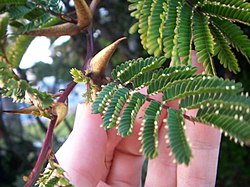 |
Psychoactive,[19] Tryptamines[25] |
 |
Tryptamine, in the leaf, stem[8] and seeds.[12] Phenethylamine in leaf and seeds[12] |
|
|
Psychoactive[16] |
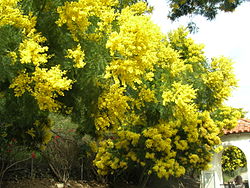 |
Psychoactive,[19] but less than 0.02% alkaloids[15] |
|
|
Psychoactive[16] |
|
|
Psychoactive,[16] but less than 0.02% alkaloids[15] |
 |
Traces of 5-MeO-DMT[26] in fruit. β-methyl-phenethylamine, flower.[27] Ether extracts about 2-6% of the dried leaf mass.[28] Alkaloids are present in the bark[29] and leaves.[30] Amphetamines and mescaline also found in tree.[25] |
|
|
Tryptamine, phenethylamine,[31] in flowers[12] other tryptamines,[32] phenethylamines[33] |
|
|
Psychoactive,[19] plus deadly toxins |
 |
Psychoactive[19] |
 |
Psychoactive[34] |
|
|
DMT, NMT |
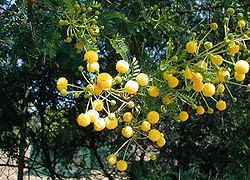 |
Psychoactive |
|
|
DMT, in the leaf[8] |
 |
0.2% tryptamine in bark, leaves, some in flowers, phenylethylamine in flowers,[31] 0.2% DMT in plant.[35] Histamine alkaloids.[15] |
|
|
Tryptamine in leaves, bark[12] |
|
|
Tryptamine[12] |
 |
0.6% NMT and DMT in about a 2:3 ratio in the stem bark, both present in leaves[8] |
 |
Psychoactive[19] |
 |
DMT, in the bark and leaf,[36] but less than 0.02% total alkaloids[15] |
 |
DMT, in the leaf[8] |
 |
DMT, in the leaf[8] |
|
|
Psychoactive, DMT in the leaf |
|
|
Tryptamine,[32] DMT, NMT, other tryptamines,[34] 0.4-0.5% in dried bark, 0.07% in branch tips.[37] |
|
|
Less than 0.1% DMT in leaf,[38][14] NMT |
|
|
Psychoactive[16] |
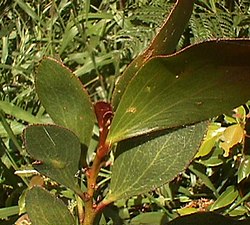 |
0.3% DMT in leaf, NMT[8] |
 |
Tryptamine in the leaf,[8] 0.5% to 2% DMT in fresh bark, phenethylamine, trace amounts[31] |
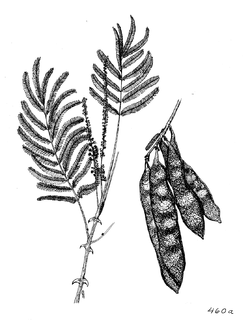 |
DMT in leaf[8] and other tryptamines in leaf, bark |
|
|
Less than 0.2% DMT in leaf, NMT; DMT and other tryptamines in leaf, bark[39] |
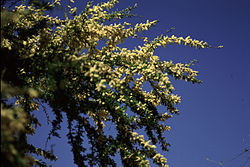 |
DMT, NMT, tryptamine, traces of amphetamines, mescaline, nicotine and others[40] |
|
|
Psychoactive[19] |
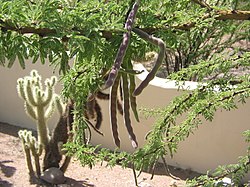 |
β-methyl-phenethylamine, Phenethylamine[41] Amphetamines and mescaline also found.[25] |
 |
Less than 0.1% DMT in leaf,[8] NMT, other tryptamines. DMT in plant,[27] DMT in bark.[12] |
|
|
DMT, in the leaf.[8] Ether extracts about 1-7% of the dried leaf mass.[28] |
 |
DMT, in the leaf[8] |
 |
DMT and NMT, in the leaf, stem and trunk bark, 0.81% DMT in bark, MMT[42][8] |
 |
DMT, NMT, and other tryptamines[34] |
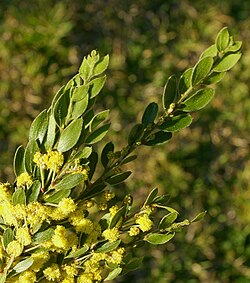 |
Tryptamine, in the leaf and stem,[8] but less than 0.02% total alkaloids[15] |
|
|
Tryptamines[32], 5-MeO-alkyltryptamine[12] |
List of Acacia Species Having Little or No Alkaloids in the Material Sampled:[15]
0%  C
C  0.02%, C...Concentration of Alkaloids [%]
0.02%, C...Concentration of Alkaloids [%]
- Albizia inundata leaves contain DMT.[19]
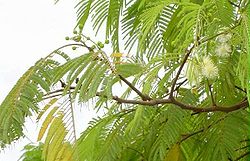 |
|
|
|
Bufotenin and Dimethyltryptamine have been isolated from the seeds and seed pods, 5-MeO-DMT from the bark of the stems.[45] The seeds were found to contain 12.4% bufotenine, 0.06% 5-MeO-DMT and 0.06% DMT.[46] |
 |
|
|
|
Bufotenine is in the seeds.[48] |
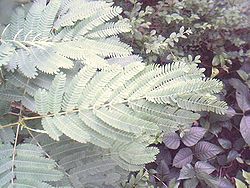 |
0% - 0.34% DMT in root bark, highly variable.[49] Also NMT, N-hydroxy-N-methyltryptamine, 2-hydroxy-N-methyltryptamine, and gramine (toxic).[50] |
 |
0.14% DMT in root bark, more reliable than D. illinoensis[49] |
|
|
Roots: 0.087% DMT,[52] Bufotenine-N-oxide 0.03% |
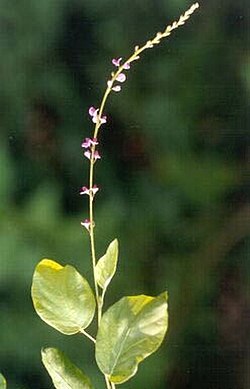 |
DMT, 5-MEO-DMT, whole plant, roots, stems, leaves[53] |
|
|
Bufotentine, DMT[54] |
 |
DMT, 5-MEO-DMT, leaves, roots[53] |
|
|
5-MEO-DMT[53] |
 |
0.0004% DMT-N-oxide, roots,[52] less in stems[52] and trace in leaves.[52] |
 |
|
 |
DMT, 5-MEO-DMT in leaves and roots[55] |
|
|
DMT, 5-MEO-DMT in leaves and root bark[53] |
|
|
Dried root: DMT 1.6%, NMT 0.0012% and hordenine 0.0065%[56] |
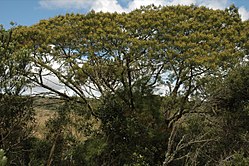 |
Tryptamine, NMT, DMT and N-methyltetrahydrocarboline in bark[57] |
|
|
Trytamines and MMT |
 |
0.31-0.57% DMT (dry root bark).[58] |
|
|
DMT[59] in root bark |
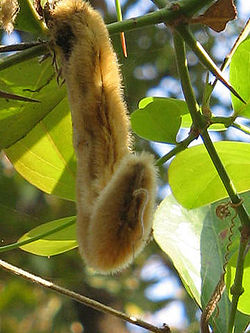 |
"The leaves, seeds, stems and roots contain L-Dopa, Serotonin, 5-HTP, and Nicotine, as well as N,N-DMT, Bufotenine, and 5-MeO-DMT."[60] |
|
|
0.4-0.5% tryptamine, DMT, etc. in leaves and stems[55] |
|
|
DMT in leaves and stems[53] |
|
|
0.2% 5-MeO-DMT, small quantities of DMT[55] DMT (dominates in seedlings and young plants), 5-MEO-DMT (dominates in mature plant), whole plant, roots, stems, leaves, flowers[53] |
Family Fabaceae: Erythrina flabelliformis, other Erythrina species, seeds contain the alkaloids Erysodin and Erysovin[61]
Malpighiaceae family:
- Diplopterys cabrerana: DMT 0.17-1.74%, average of 0.47% DMT[62]
Myristicaceae (Nutmeg family):
- Horsfieldia superba: 5-MeO-DMT[55] and beta-carbolines[5]
- Iryanthera macrophylla: 5-MeO-DMT in bark[55]
- Iryanthera ulei: 5-MeO-DMT in bark[53]
- Osteophloem platyspermum: DMT, 5-MeO-DMT in bark[53]
- Virola genus; for example:
| Virola calophylla | Leaves 0.149% DMT, leaves 0.006% MMT[53] 5-MeO-DMT in bark[63] |
| Virola callophylloidea | DMT |
| Virola carinata | DMT in leaves[53] |
| Virola cuspidata | DMT[6] |
| Virola divergens | DMT in leaves[53] |
 |
DMT, 5-MEO-DMT in bark, roots, leaves and flowers[53] |
| Virola melinonii | DMT in bark[53] |
| Virola multinervia | DMT, 5-MEO-DMT in bark and roots[53] |
| Virola pavonis | DMT in leaves[53] |
| Virola peruviana | 5-MEO-DMT, traces of DMT and 5-MeO-tryptamine in bark[53] |
| Virola rufula | Alkaloids in bark and root, 95% of which is MeO-DMT[64] 0.190% 5-MeO-DMT in bark,[53] 0.135% 5-MeO-DMT in root, 0.092% DMT in leaves.[53] |
| Virola sebifera | The bark contains 0.065% to 0.25% alkaloids, most of which are DMT and 5-MeO-DMT.[65] |
| Virola surinamensis | DMT[6] in bark[53] |
| Virola venosa | DMT, 5-MEO-DMT in roots, leaves[53] DMT |
- Testulea gabonensis: 0.2% 5-MeO-DMT, small quantities of DMT,[55] DMT in bark and root bark[53], NMT
Genus Pandanus (Screw Pine): DMT in nuts[55]
Poaceae family (Gramineae):
Some Graminae (grass) species contain gramine, which can cause brain damage, other organ damage, central nervous system damage and death in sheep.[66]
| Species |
|
 |
|
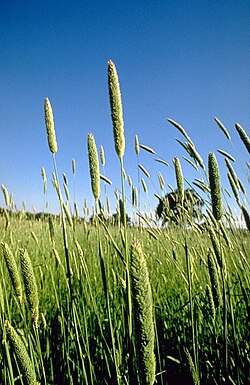 |
|
 |
|
|
|
|
 |
|
None of the above alkaloids are said to have been found in Phalaris californica, Phalaris canariensis, Phalaris minor and hybrids of P. arundinacea together with P. aquatica.[68]
- Punica granatum "DMT in root cortex;"[6] The dried stem and root bark of the tree contain about 0.4-0.9% alkaloids.[70]
Rubiaceae family:
|
|
|
|
|
|
|
|
|
|
|
|
|
|
|
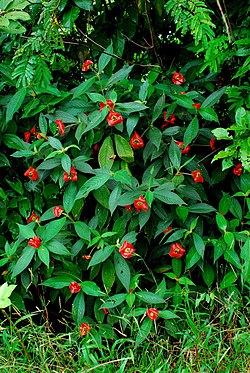 |
|
|
|
|
|
|
|
 |
|
Rutaceae family:
|
|
|
 |
|
|
|
|
|
|
|
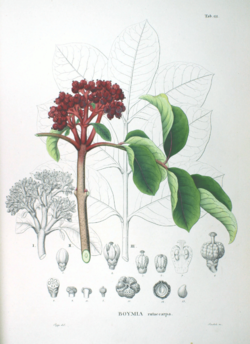 |
|
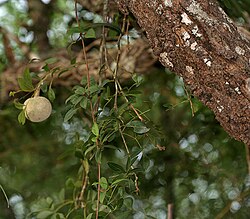 |
|
|
|
|
|
|
|
|
|
|
|
|
|
|
|
|
- Urtica pilulifera: Bufotenin[6]
[edit] Other Alkaloids
[edit] Mescaline
|
|
|
|
|
|
|
|
 |
|
|
 |
|
|
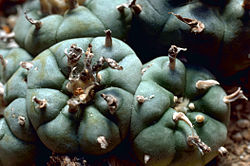 |
|
|
 |
|
|
 |
-dimethoxyphenethylamine[75] |
|
|
|
|
|
 |
|
|
|
|
|
|
 |
|
|
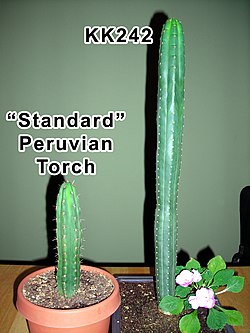 |
|
|
|
|
|
|
 |
|
|
|
|
|
[edit] Plants containing beta-carbolines
Beta-carbolines are "reversible" MAO-A inhibitors. They are found in some plants used to make Ayahuasca. In high doses the harmala alkaloids are somewhat hallucinogenic on their own.
|
|
Harmine |
|
|
Beta-carbolines[82] |
|
|
Beta-carbolines[82] |
 |
Harmalol |
|
|
Harman |
|
|
Beta-carbolines[82] |
- Newbouldia laevis, Harman
 |
Harmine |
- Hammada leptoclada, Tetrahydroharman, etc.
- Kochia scoparia, Harmine, etc.
- Guiera senegalensis, Harman, etc.
- Carex brevicollis, Harmine, etc.
- Carex parva, Beta-carbolines[82]
 |
Harman, etc. |
 |
Beta-carbolines[82] |
|
|
Tetrahydroharman, etc. |
|
|
Tetrahydroharman |
|
|
Tetrahydroharman |
|
|
Harman, etc. |
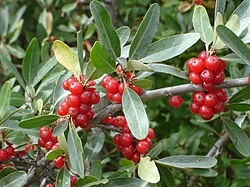 |
Tetrahydroharmol |
 |
Tetrahydroharmol |
 |
Tetrahydroharman |
 |
Harman, etc. |
 (Perennial Ryegrass) |
Harman, etc. |
|
|
Beta-carbolines[82] |
|
|
Beta-carbolines[82] |
- Nectandra megapotamica, Beta-carbolines[82]
- Acacia baileyana, Tetrahydroharman
- Acacia complanata, Tetrahydroharman, etc.
- Burkea africana, Harman, etc.
- Desmodium gangeticum, Beta-carbolines[82]
- Desmodium gyrans, Beta-carbolines[82]
- Desmodium pulchellum, Harman, etc.
- Mucuna pruriens, 6-Methoxy-Harman
- Petalostylis labicheoides, Tetrahydroharman; MAO's up to 0.5%[6]
- Prosopis nigra, Harman, etc.
- Shepherdia pulchellum, Beta-carbolines[82]
- Strychnos melinoniana, Beta-carbolines[82]
- Strychnos usambarensis, Harman[82]
|
|
5-methoxytetrahydroharman, (-)-N(6)-methoxytetrahydroharman, dimethyltryptamine-N(6)-oxide[9] |
 |
Harmine 0.31-8.43%,[83] tetrahydroharmine, telepathine, dihydroshihunine,[84] 5-MeO-DMT in bark[85] |
|
|
Beta-carbolines[82] |
|
|
Harmine, telepathine[9] |
|
|
Harmine, telepathine[9] |
|
|
Harmine up to 6%, harmaline up to 4%, plus DMT[86] |
|
|
Beta-carbolines[82] |
|
|
Beta-carbolines[82] |
|
|
Harmine |
- Gymnacranthera paniculata, Beta-carbolines[82]
- Horsfieldia superba: Beta-carbolines[5]
- Virola cuspidata, 6-Methoxy-Harman
- Virola rufula, Beta-carbolines[82]
- Virola theidora, Beta-carbolines[82]
- Testulea gabonensis, Beta-carbolines[82]
- Plectocomiopsis geminiflorus, Beta-carbolines[82]
|
|
|
 |
|
|
|
|
|
|
|
|
|
|
 |
|
Passifloraceae:
|
|
|
 |
|
|
|
|
|
|
|
 |
|
|
|
|
|
|
|
 |
|
|
|
|
 |
|
 |
Harmine, Harmaline, Harman, etc. 0.03%.[87] Alkaloids in rind of fruit 0.25%[87] |
 |
|
|
|
|
 |
|
|
|
|
- Calligonum minimum, Beta-carbolines[82]
- Leptactinia densiflora, Leptaflorine, etc.
- Ophiorrhiza japonica, Harman
- Pauridiantha callicarpoides, Harman
- Pauridiantha dewevrei, Harman
- Pauridiantha lyalli, Harman
- Pauridiantha viridiflora, Harman
- Simira klugii, Harman
- Simira rubra, Harman
- Borreria verticillata, Beta-carbolines[82]
- Leptactinia densiflora, Beta-carbolines[82]
- Nauclea diderrichii, Beta-carbolines[82]
- Ophiorrhiza japonica, Beta-carbolines[82]
- Pauridiantha callicarpoides, Beta-carbolines[82]
- Pauridiantha dewevrei, Beta-carbolines[82]
- Pauridiantha yalli, Beta-carbolines[82]
- Pauridiantha viridiflora, Beta-carbolines[82]
- Pavetta lanceolata, Beta-carbolines[82]
- Psychotria carthagenensis, Beta-carbolines[82]
- Psychotria viridis, Beta-carbolines[82]
- Simira klugii, Beta-carbolines[82]
- Simira rubra, Beta-carbolines[82]
- Uncaria attenuata, Beta-carbolines[82]
- Uncaria canescens, Beta-carbolines[82]
- Uncaria orientalis, Beta-carbolines[82]
Rutaceae family:
- Tetradium (syn. Evodia) species: Some contain carbolines
- Euodia leptococca: Beta-carboline[5]
- Araliopsis tabouensis, Beta-carbolines[82]
- Findersia laevicarpa, Beta-carbolines[82]
- Xanthoxylum rhetsa, Beta-carbolines[82]
- Chrysophyllum lacouritianum, Norharman etc.
- Ailanthus malabarica, Beta-carbolines[82]
- Perriera madagascariensis, Beta-carbolines[82]
- Picrasma ailanthoides, Beta-carbolines[82]
- Picrasma crenata, Beta-carbolines[82]
- Picrasma excelsa, Beta-carbolines[82]
- Picrasma javanica, Beta-carbolines[82]
- Vestia foetida, (Syn V. lycioides) Beta-carbolines[82]
- Symplocaceae:
- Symplocos racemosa, Harman
- Grewia mollis, Beta-carbolines[82]
 |
|
|
|
|
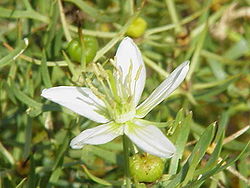 (Syrian Rue) |
The seeds contain about 2-6% alkaloids, most of which is harmaline.[88] Peganum harmala is also an abortifacient. |
|
|
|
 |
|
 |
|
[edit] Other psychedelic plants
 |
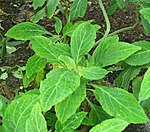
|
Salvinorin A, 0.89-3.87 mg/g, also Salvinorin B and Salvinorin C[90] |
 |
|
Seeds contain high amounts of LSA (also known as d-lysergic acid amide, d-lysergamide, ergine, and LA-111), often 50-150X the amounts found in Ipomoea violacea. |
 |
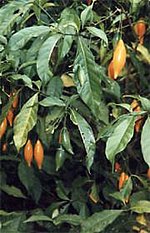
|
Ibogaine in root bark[91] |
 |
Ibogaine in root leaves[91] | |
 |
Ibogaine and similar alkaloids[91] | |
 |
Tabernaemontana sp. |
Ibogaine[91] |
 |

|
Ibogaine[92] |
 |

|
Recent studies have shown Nymphaea caerulea to have psychedelic properties, and may have been used as a sacrament in ancient Egypt and certain ancient South American cultures. Dosages of 5 to 10 grams of the flowers induces slight stimulation, a shift in thought processes, enhanced visual perception, and mild closed-eye visuals. Nymphaea caerulea is related to, and possesses similar activity as Nelumbo nucifera, the Sacred Lotus. Both Nymphaea caerulea and Nelumbo nucifera contain the alkaloids nuciferine and apomorphine, which have been recently isolated by independent labs.[citation needed]
These psychoactive effects make Nymphaea caerulea a likely candidate (among several) for the lotus plant eaten by the mythical Lotophagi in Homer's Odyssey. Used in aromatherapy, Nymphaea caerulea is purported to have a "divine" essence, bringing euphoria, heightened awareness and tranquility.[citation needed] Other sources cite anti-spasmodic and sedative, purifying and calming properties. |
 |

|
Both leaves and flowers (where most concentrated) contain Leonurine. (Effects reminiscent of marijuana) |
 |

|
Both leaves and flowers (where most concentrated) contain Leonurine. (Effects reminiscent of marijuana) |
 |

|
Produces vivid dreams after smoking. It is also employed by the Chontal people as a medicinal herb against gastrointestinal disorders, and is used as an appetizer, cathartic anti-dysentery remedy, and as a fever-reducing agent. |
 |
|
|
|
Seeds contain D-lysergic acid amide, lysergol, and turbicoryn; lysergic acid alkaloids up to 0.03%[94] |
|
|
|
Apocynaceae family:
- Catharanthus roseus is (perhaps unpleasantly) "hallucinogenic."[95]
- Vinca minor
Aquifoliaceae family:
- Ilex guayusa, which is used as an additive to some versions of Ayahuasca.[96] According to the Ecuadorian indigenous, it is also slightly hallucinogenic on its own, when drunk in high enough quantities.
Euphorbiaceae family:
Loganaceae family:
- Desfontainia spinosa, causes visions[97]
Lythraceae family:
- Heimia myrtifolia, auditory[98]
- Heimia salicifolia, auditory[98]
[edit] See also
- Aztec entheogenic complex
- List of Entheogens
- List of poisonous plants
- Louisiana State Act 159
- Psilocybin mushrooms
[edit] References
- ^ "Ayahuasca Analogues". www.serendipity.li. http://www.serendipity.li/dmt/hoasca.html. Retrieved on 2008-02-23.
- ^ IJ PACHTER, DE ZACHARIAS, O RIBEIRO - The Journal of Organic Chemistry, 1959 -
- ^ a b c d e f g h i j k l m n Trouts Notes on Sacred Cacti
- ^ "Profiles of Psychedelic Drugs". paranoia.lycaeum.org. http://paranoia.lycaeum.org/psychedelics/tryptamines/dmt.info. Retrieved on 2008-04-19.
- ^ a b c d e Bluezoo Tryptamines
- ^ a b c d e f g h i j k l m Plants Containing DMT
- ^ "Lycaeum > Leda > Acacia acuminata". leda.lycaeum.org. http://leda.lycaeum.org/?ID=15928. Retrieved on 2008-02-23.
- ^ a b c d e f g h i j k l m n o p Shaman Australis
- ^ a b c d Glasby, John Stephen (1991). Dictionary of Plants Containing Secondary Metabolites. CRC Press. p. 2. ISBN 0850664233. http://books.google.com/books?id=te53VV5u8YMC&pg=RA1-PA2&ots=e5Swnj0FN9&dq=acacia+alkaloids&sig=ph1WfGlPnw5YMc3SReh2P5li2ls.
- ^ English Title: Nutritive value assessment of the tropical shrub legume Acacia angustissima: anti-nutritional compounds and in vitro digestibility. Personal Authors: McSweeney, C. S., Krause, D. O., Palmer, B., Gough, J., Conlan, L. L., Hegarty, M. P. Author Affiliation: CSIRO Livestock Industries, Long Pocket Laboratories, 120 Meiers Road, Indooroopilly, Qld 4068, Australia. Document Title: Animal Feed Science and Technology, 2005 (Vol. 121) (No. 1/2) 175-190
- ^ Maya Ethnobotanicals
- ^ a b c d e f g h Acacia (Polish)
- ^ Lycaeum
- ^ a b www.serendipity.com
- ^ a b c d e f g Chemotaxonomie der Pflanzen By Robert Hegnauer
- ^ a b c d e www.bushfood.net
- ^ Duboisia hopwoodii - Pituri Bush - Solanaceae - Central America
- ^ Ask Dr. Shulgin Online: Acacias and Natural Amphetamine
- ^ a b c d e f g h Index of Rätsch, Christian. Enzyklopädie der psychoaktiven Pflanzen, Botanik, Ethnopharmakologie und Anwendungen, 7. Auflage. AT Verlag, 2004, 941 Seiten. ISBN 3855025703 at [1] (German)
- ^ www.abc.net.au
- ^ Acacia Complanata Phytochemical Studies
- ^ Lycaeum -- Acacias and Entheogens
- ^ Lycaeum
- ^ NMR spectral assignments of a new chlorotryptamine alkaloid and its analogues from Acacia confusa Malcolm S. Buchanan, Anthony R. Carroll, David Pass, Ronald J. Quinn Magnetic Resonance in Chemistry Volume 45, Issue 4 , Pages359 - 361. John Wiley & Sons, Ltd.
- ^ a b c Naturheilpraxis Fachforum (German)
- ^ Lycaeum
- ^ a b c Dr. Duke's Phytochemical and Ethnobotanical Databases
- ^ a b Wattle Seed Workshop Proceedings 12 March 2002, Canberra March 2003 RIRDC Publication No 03/024, RIRDC Project No WS012-06
- ^ www.bpi.da.gov.ph
- ^ Purdue University
- ^ a b c Hegnauer, Robert (1994). Chemotaxonomie der Pflanzen. Springer. p. 500. ISBN 3764329793. http://books.google.com/books?id=9fDv1RYqIRkC&dq=chemotaxonomie+der+pflanzen&printsec=frontcover&source=web&ots=kkne5dmPiX&sig=iprrFOkR3ClREUcAyMORs0lGjdY#PPA290,M1.
- ^ a b c www.bluelight.ru
- ^ "Lycaeum > Leda > Acacia floribunda". leda.lycaeum.org. http://leda.lycaeum.org/?ID=16001. Retrieved on 2008-02-23.
- ^ a b c d wiki.magiskamolekyler.org (Swedish)
- ^ "Lycaeum > Leda > Acacia longifolia". leda.lycaeum.org. http://leda.lycaeum.org/?ID=15799. Retrieved on 2008-02-23.
- ^ extentech.sheetster.com
- ^ Acacia obtusifolia Phytochemical Studies
- ^ Plants Containing DMT (German)
- ^ "Acacia campylacantha - Hortipedia". www.hortipedia.org. http://www.hortipedia.org/de/index.php?title=Acacia_campylacantha. Retrieved on 2008-02-23.
- ^ "Acacia rigidula - Magiska Molekylers Wiki". wiki.magiskamolekyler.org. http://wiki.magiskamolekyler.org/Acacia_rigidula. Retrieved on 2008-02-23.
- ^ Chemistry of Acacias from South Texas
- ^ Arbeitsstelle für praktische Biologie (APB)
- ^ a b c d e f g UNO
- ^ a b c d e f g h i Dr. Duke's Phytochemical and Ethnobotanical Databases
- ^ Herbotechnica (Spanish)
- ^ "Bufo alvarius - Jonathan Ott on Bufotenine". www.erowid.org. http://www.erowid.org/archive/sonoran_desert_toad/ott.htm. Retrieved on 2008-02-23.
- ^ Psychedelics Encyclopedia By Peter G. Stafford, p. 313.
- ^ PubMed
- ^ a b Desmanthus (Ayahuasca: alkaloids, plants & analogs)
- ^ "Google Book Search". books.google.com. http://books.google.com/books?id=bUV8C6iLFkEC&pg=PA236&lpg=PA236&dq=%22Mimosa+somnians%22&source=web&ots=5KzgBm6X_5&sig=Rh_GpZxz_cB0AX73SDgeIpkvl84&hl=en#PPA199,M1. Retrieved on 2008-05-08.
- ^ "Desmodium caudatum information from NPGS/GRIN". www.ars-grin.gov. http://www.ars-grin.gov/cgi-bin/npgs/html/taxon.pl?311307. Retrieved on 2008-05-02.
- ^ a b c d Trout's Notes on Desmodium
- ^ a b c d e f g h i j k l m n o p q r s t u v w x y z aa ab ac ad ae af ag ah "Ayahuasca Analogues". www.serendipity.li. http://www.serendipity.li/dmt/hoasca.html. Retrieved on 2008-04-28.
- ^ Pharmaceutical-Neutraceutical Bulletin, Final
- ^ a b c d e f g h i .
- ^ "Isolation and Identification of Putative Hallucinogenic Constituents from the Roots of Mimosa ophthalmocentra - Pharmaceutical Biology". www.informaworld.com. http://www.informaworld.com/smpp/content~content=a714019539~db=all. Retrieved on 2008-04-20.
- ^ "Google Book Search". books.google.com. http://books.google.com/books?id=bUV8C6iLFkEC&pg=PA236&lpg=PA236&dq=%22Mimosa+somnians%22&source=web&ots=5KzgBm6X_5&sig=Rh_GpZxz_cB0AX73SDgeIpkvl84&hl=en#PPA208,M1. Retrieved on 2008-05-07.
- ^ Ask Erowid ID 75
- ^ "UNODC Bulletin on Narcotics 1969". http://www.unodc.org/unodc/en/bulletin/bulletin_1969-01-01_4_page004.html.
- ^ Erowid entry(2002), [2]
- ^ "Kalifornischer Korallenstrauch (Erythrina decora) im GIFTPFLANZEN.COMpendium - www.giftpflanzen.com". www.giftpflanzen.com. http://www.giftpflanzen.com/erythrina_flabelliformis.html. Retrieved on 2008-04-18.
- ^ DMT Plants List
- ^ "Species Information". sun.ars-grin.gov. http://sun.ars-grin.gov:8080/npgspub/xsql/duke/plantdisp.xsql?taxon=1065. Retrieved on 2008-04-11.
- ^ a b www.tryptamines.com
- ^ COMMITTEE FOR VETERINARY MEDICINAL PRODUCTS VIROLA SEBIFERA SUMMARY REPORT
- ^ "Toxicants of Plant Origin - Google Book Search". books.google.com. http://books.google.com/books?hl=en&lr=&ie=UTF-8&id=eASgQyXq8xMC&oi=fnd&pg=PA169&dq=%22mimosa+hostilis%22+dimethyltryptamine&ots=pe6oz-oODM&sig=D6kaAQYmEqSOkJ4kkztPcm2K10I#PPA171,M1. Retrieved on 2008-04-20.
- ^ Erowid Arundo Donax Info Page 1
- ^ a b c Lycaeum
- ^ a b c Erowid Phalaris FAQ
- ^ Pomegranate (Herbdata New Zealand)
- ^ Amazing Nature
- ^ http://www.thenook.org/archives/tek/alklist.htm
- ^ Trichocereus
- ^ a b c d Forbidden Fruit Archives
- ^ a b c d e f g h Visionary Cactus Guide
- ^ a b Erowid
- ^ Austrocylindropuntia cylindrica (http://www.desert-tropicals.com)
- ^ Cylindropuntia spinosior (www.desert-tropicals.com)
- ^ a b c Partial List of Alkaloids in Trichocereus Cacti
- ^ Echinopsis tacaquirensis ssp. taquimbalensis
- ^ www.desert-tropicals.com
- ^ a b c d e f g h i j k l m n o p q r s t u v w x y z aa ab ac ad ae af ag ah ai aj ak al am an ao ap aq ar as at au av aw ax ay az ba bb bc bd Angiosperm Families Containing Beta-Carbolines
- ^ Callaway JC, Brito GS & Neves ES (2005). Phytochemical analyses of Banisteriopsis caapi and Psychotria viridis. Journal of Psychoactive Drugs 37(2): 145-150.
- ^ John Stephen Glasby, Dictionary of Plants Containing Secondary Metabolites, Published by CRC Press
- ^ "Chemical Information". sun.ars-grin.gov. http://sun.ars-grin.gov:8080/npgspub/xsql/duke/chemdisp.xsql. Retrieved on 2008-04-11.
- ^ "Silbrige Ayahuasca-Liane (Banisteriopsis muricata) im GIFTPFLANZEN.COMpendium - www.giftpflanzen.com". www.giftpflanzen.com. http://www.giftpflanzen.com/banisteriopsis_muricata.html. Retrieved on 2008-04-18.
- ^ a b www.drugs.com
- ^ www.amazing-nature.com
- ^ "Alkaloids and phenylpropanoids from Peganum nigellastrum". Phytochemistry. http://proxify.com/p/011010A1000110/687474703a2f2f7777772e736369656e63656469726563742e636f6d2f736369656e63653f5f6f623d41727469636c6555524c265f7564693d42365448372d343031484747542d3152265f757365723d3130265f72646f633d31265f666d743d265f6f7269673d736561726368265f736f72743d6426766965773d63265f616363743d43303030303530323231265f76657273696f6e3d31265f75726c56657273696f6e3d30265f7573657269643d3130266d64353d6631346535636632633161653335346164393536316232336262646533643236. Retrieved on 2008-01-12.
- ^ Clones of Salvia divinorum
- ^ a b c d Tihkal
- ^ Trachelospermum jasminoides (www.giftpflanzen.com)
- ^ "Trichterwinde (Ipomoea violacea) im GIFTPFLANZEN.COMpendium - www.giftpflanzen.com". www.giftpflanzen.com. http://www.giftpflanzen.com/ipomoea_violacea.html. Retrieved on 2008-04-18.
- ^ "Ololiuqui (Rivea corymbosa) im GIFTPFLANZEN.COMpendium - www.giftpflanzen.com". www.giftpflanzen.com. http://www.giftpflanzen.com/rivea_corymbosa.html. Retrieved on 2008-04-18.
- ^ Catharanthus roseus
- ^ Ayahuasca Analogues
- ^ Schultes, Richard Evans, Iconography of New World Plant Hallucinogens. p. 101
- ^ a b Sinicuichi FAQ
[edit] External links
- Descriptions of psychoactive Cacti. Lycaeum Visionary Cactus Guide
- Erowid Tryptamine FAQ -- More Plants Containing Tryptamines
- John Stephen Glasby, Dictionary of Plants Containing Secondary Metabolites, Published by CRC Press
- Golden Guide to Hallucinogenic Plants
- Hallucinogens on the Internet: A Vast New Source of Underground Drug Information John H. Halpern, M.D. and Harrison G. Pope, Jr., M.D.
- Peter L. Katavic, Chemical Investigations of the Alkaloids From the Plants Of The Family Elaeocarpaceae, School of Science/Natural Product Discovery (NPD), Faculty of Science, Griffith University
- Alexander T. Shulgin, Psychotomimetic Drugs: Structure-Activity Relationships
- UNODC The plant kingdom and hallucinogens (part II)
- UNODC The plant kingdom and hallucinogens (part III)
- Virola -- Dried Herbarium Specimens
- Virola Species Pictures -- USGS
- Desmanthus illinoensis -- USDA
- A General Introduction to Ayahuasca
- Psychedelic Reader (Google Books)
